การใช้ Gerund And Infinitive
Gerund และ Infinitive เป็นส่วนหนึ่งของไวยากรณ์ภาษาอังกฤษที่ใช้ในประโยค เพื่อแสดงการกระทำ หรือรายละเอียดเกี่ยวกับคำกริยาที่เราต้องการจะกล่าวถึง ในภาษาไทย การใช้ Gerund และ Infinitive นั้นมีลักษณะและกฎเฉพาะของตัวเองที่มีความแตกต่างกัน ดังนั้นในบทความนี้เราจะได้รู้จักหน้าที่และลักษณะของ Gerund และ Infinitive รวมถึงวิธีการใช้และตัวอย่างประโยคที่เกี่ยวข้องกับทั้งสองอย่าง
การรู้จักกับ Gerund (การกระทำที่เป็นคำนาม)
Gerund เป็นรูปพจน์ที่มีลักษณะคล้ายกับคำนาม แต่ใช้เพื่อแสดงการกระทำ หรือการใช้งานของคำกริยา ซึ่ง Gerund จะมีรูปแบบดังนี้: Verb + -ing
ยกตัวอย่างเช่น:
– Swimming is my favorite hobby. (การว่ายน้ำเป็นงานอดิเรกที่ฉันชื่นชอบ)
– I enjoy singing. (ฉันชอบการร้องเพลง)
หลังจากกล่าวถึงหน้าที่และลักษณะของ Gerund มาแล้ว การเตรียมตัวในการใช้งาน Gerund นั้นจะมีรูปแบบเดียวกับการใช้งานคำนามทั่วไป
กรณีพิเศษที่ Gerund สามารถใช้ได้:
1. หลัง Preposition: ในบางกรณี Gerund สามารถมาตามหลังคำบุพบท (Preposition) เช่น in, at, for, after เพื่อแสดงการกระทำหรือสภาพที่เกี่ยวข้องกับคำที่ตามหลัง เช่น:
– I’m good at playing basketball. (ฉันเก่งในการเล่นบาสเกตบอล)
– She’s afraid of flying. (เธอกลัวการบิน)
2. หลังขณะเปลี่ยนเป็นกรณีวิเศษ: เมื่อบางคำกริยาถูกเปลี่ยนรูปแบบมาใช้เป็นแบบคำกริยาที่ใช้เป็นชื่อ (Verbal Noun) หรือ Gerund ทั้งแบบ Infinitive และ Gerund สามารถใช้แทนกันได้ในกรณีนี้ เช่น:
– He stopped smoking. = He stopped to smoke. (เขาเลิกสูบบุหรี่)
– She remembered locking the door. = She remembered to lock the door. (เธอยังชื่นชมการล็อกประตู)
การใช้ Gerund ในประโยค:
Gerund ที่ใช้ในประโยคสามารถแทนที่จะเป็นกรรม ซึ่งมีหลายรูปแบบและสามารถอยู่ตำแหน่งต่าง ๆ ตามกรรมวิเศษของประโยค เช่น:
1. กรรมวิเศษรูปแบบที่ 1: Subject + Verb + Object + Gerund
– I saw him playing tennis. (ฉันเห็นเขาเล่นเทนนิส)
2. กรรมวิเศษรูปแบบที่ 2: Subject + Verb + Gerund + Object
– She loves reading books. (เธอรักการอ่านหนังสือ)
3. ไม่มีกรรม: Subject + Verb + Gerund
– Running is good for your health. (วิ่งเป็นสิ่งดีต่อสุขภาพของคุณ)
การเชื่อมต่อ Gerund กับคำอื่น ๆ:
Gerund สามารถเชื่อมต่อกับคำอื่น เพื่อแสดงความสัมพันธ์หรือประโยคที่สมบูรณ์ โดยใช้คำที่แสดงถึงการกระทำนั้น เช่น:
– I enjoy swimming and hiking. (ฉันชอบการว่ายน้ำและการเดินเท้า)
– He likes playing guitar while singing. (เขาชอบการเล่นกีตาร์ในขณะที่ร้องเพลง)
การรู้จักกับ Infinitive (คำกริยาช่วย)
Infinitive เป็นรูปพจน์ของคำกริยาที่บอกถึงการกระทำหรือสภาพแบบไม่จำกัด และไม่มีรูปอพยพเฉพาะของเวลา ในภาษาอังกฤษ รูป Infinitive (to-infinitive) จะมีรูปแบบดังนี้: to + Verb
ยกตัวอย่างเช่น:
– I like to swim in the pool. (ฉันชอบจะว่ายน้ำในสระ)
– She wants to learn how to play the piano. (เธออยากเรียนรู้ว่าจะเล่นเปียโน)
หลังจากได้รู้จักลักษณะและหน้าที่ของ Infinitive แล้ว การเตรียมตัวในการใช้งาน Infinitive นั้นจะต้องใช้ “to” ต่ำหน้ากับ Infinitive แต่ในบางกรณีก็ไม่จำเป็นต้องใช้ อย่างเช่นหลังกริยาหลักในประโยคแสดงคำรับรอง หรือคำเสนอแนะ เช่น:
– She asked me to help her. (เธอขอให้ฉันช่วยเธอ)
– He told us to be quiet. (เขาบอกเราให้เงียบ)
กรณีพิเศษที่ Infinitive สามารถใช้ได้:
1. หลังคำกริยาหลักเพียงแค่ Verb: ในบางกรณี Infinitive อาจถูกใช้เพียงในรูปแบบของคำกริยาหลัก (Main Verb) เพียงแค่คำเดียว เช่น:
– He can swim. (เขาสามารถว่ายน้ำได้)
2. หลังคำกริยาที่เฉพาะเจาะจง: เมื่อ Infinitive ถูกใช้หลังคำกริยาที่เฉพาะเจาะจง เช่น want, need, hope, plan, decide, expect, learn เป็นต้น โดยที่กริยาหลักเกิดเปลี่ยนแปลงของคำนาม ซึ่งจะมีรูปแบบตามด้านล่าง:
– I want to go to the beach. (ฉันอยากจะไปชายหาด)
– They plan to travel around the world. (พวกเขาวางแผนที่จะเดินทางไปทั่วโลก)
การใช้ Infinitive ในประโยค:
Infinitive สามารถใช้สร้างประโยคหรือเติมเต็มความหมายให้กับคำกริยาหรือประโยคที่เตรียมไว้ โดยมีรูปแบบดังนี้:
1. กรรมวิเศษรูปแบบที่ 1: Subject + Verb + Object + Infinitive
– I saw him leave the room. (ฉันเห็นเขาออกจากห้อง)
2. กรรมวิเศษรูปแบบที่ 2: Subject + Verb + Infinitive + Object
– She loves to read books. (เธอรักการอ่านหนังสือ)
3. ไม่มีกรรม: Subject + Verb + Infinitive
– He wants to buy a new car. (เขาต้องการจะซื้อรถใหม่)
การเชื่อมต่อ Infinitive กับคำอื่น ๆ:
เช่นเดียวกับ Gerund Infinitive สามารถเชื่อมต่อกับคำอื่น ๆ เพื่อเพิ่มความหมายหรือแสดงความสัมพันธ์ โดยใช้คำที่แสดงถึงการกระทำกับ Infinitive นั้น หรือเสริมความหมาย เช่น:
– She needs to eat something. (เธอต้องการที่จะกินอะไรบางอย่าง)
– He decided to quit his job and start a business. (เขาตัดสินใจเลิกงานและเริ่มธุรกิจของตัวเอง)
Gerund and Infinitive Test
คุณคิดว่าคุณเข้าใจเรื่อง Gerund และ Infinitive แล้วหรือยัง? ลองทำแบบทดสอบเหล่านี้เพื่อทดสอบความรู้ของคุณ:
1. What is the gerund form of the verb “swim”?
a) swim
b) swimming
c) swam
d) swum
2. Which sentence uses gerund correctly?
a) She enjoys to read books.
b) They stopped to talk to their friends.
c) I like play basketball.
d) Running is good for your health.
3. What is the infinitive form of the verb “learn”?
a) learning
b) learns
c) learned
d) to learn
4. Which sentence uses infinitive correctly?
a) I can to go to the store.
b) She wants go to the beach.
c) They decided to stay at home.
d) He expects to seeing his friends.
Gerund คืออะไร?
Gerund เป็นรูปของคำกริยาที่มีลักษณะคล้ายคำนาม และใช้เพื่อแสดงการกระทำหรือการใช้งานของคำกริยา
Gerund มีอะไรบ้าง?
Gerund คือรูปพจน์ของคำกริยาที่มีลักษณะคล้ายคำนาม โดยมีรูปแบบ Verb + -ing
Infinitive คืออะไร?
Infinitive เป็นรูปของคำกริยาที่ไม่จำกัดเวลา และใช้เพื่อแสดงการกระทำหรือสภาพแบบไม่จำกัด
Gerund and Infinitive ต่างกันอย่างไร?
Gerund และ Infinitive เป็นรูปชุดต่างกันของคำกริยา โดย Gerund มีลักษณะคล้ายคำนามและใช้เพื่อแสดงการกระทำ ในขณะที่ Infinitive ใช้เพื่อแสดงการกระทำและสภาพที่ไม่จำกัด
ตัวอย่างประโยค verb + gerund:
– I enjoy swimming
Verb + Infinitive, Verb + Gerund ต่างกันยังไง?
คำสำคัญที่ผู้ใช้ค้นหา: การใช้ gerund and infinitive Gerund and infinitive test, Gerund คือ, gerund มีอะไรบ้าง, Infinitive คือ, gerund and infinitive ต่างกันอย่างไร, verb+gerund ตัวอย่าง, Infinitive with to, To infinitive คือ
รูปภาพที่เกี่ยวข้องกับหัวข้อ การใช้ gerund and infinitive

หมวดหมู่: Top 99 การใช้ Gerund And Infinitive
Gerund And To Infinitive ใช้ยังไง
Gerund เป็นรูปที่แปลงคำกริยาให้กลายเป็นคำนาม โดยเพิ่ม -ing ที่เป็นส่วนประกอบบนต้นคำกริยา การใช้ Gerund สามารถใช้ได้แทบทุกส่วนของประโยค ตั้งแต่เป็น เป็นกรรม หรือเป็นประธาน โดยมักจะมีความหมายเช่นเดียวกับคำนาม ตัวอย่างเช่น:
– I enjoy swimming. (ฉันชอบการว่ายน้ำ)
– She is good at painting. (เธอเก่งในการวาดภาพ)
– Reading books is my favorite hobby. (การอ่านหนังสือเป็นงานอดิเรกที่ชอบของฉัน)
To Infinitive เป็นรูปที่แปลงคำกริยาให้กลายเป็นรูปไม่ติดกับเวลา เนื่องจากใช้เป็นรูปฐานของคำกริยา เพื่อให้มีความหมายตามคำมุกหมิกที่ตามมา รูปของ To Infinitive จะเป็นคำกริยาต้น ตามด้วย “to” ที่ติดกับคำกริยา ไม่ว่าคำกริยาจะเป็น tense อะไรก็ตาม การใช้ To Infinitive เน้นการให้คำกำหนด หรือการเตือนเสมอ เช่น:
– I want to travel the world. (ฉันอยากเดินทางรอบโลก)
– She needs to study harder. (เธอต้องเรียนหนักขึ้น)
– They decided to buy a new car. (พวกเขาตัดสินใจที่จะซื้อรถใหม่)
การใช้ Gerund และ To Infinitive นั้นแตกต่างกันตามลักษณะคำกริยาที่มากำกับ ดังนี้:
1. Gerund
– เป็นกิริยาที่ใช้หลัง prepositions เช่น: after, before, without, by
– เข้ากับกริยาบอกเหตุผล เช่น: enjoy, mind, prefer, avoid
– เป็นกริยาหลักของประโยค เช่น: I like swimming.
– ใช้หลังกริยาบอกความรู้สึก เช่น: regret, love, hate, enjoy
2. To Infinitive
– เป็นกิริยาที่อยู่หน้ากริยาบอกเหตุผล เช่น: want, need, decide, hope
– ใช้หลังกริยาบอกคำสั่ง เช่น: ask, tell, order, invite
– ใช้หลังกริยาธุระ เช่น: can, must, might, would
ตัวอย่างการใช้ Gerund และ To Infinitive:
– She enjoys dancing. (เธอชอบการเต้น)
– They decided to go shopping. (พวกเขาตัดสินใจที่จะไปช็อปปิ้ง)
– I avoid eating fast food. (ฉันหลีกเลี่ยงการกินอาหารจานด่วน)
– He needs to finish his homework. (เขาต้องเสร็จงานบ้านของเขา)
คำถามที่พบบ่อยสำหรับ Gerund และ To Infinitive:
Q: What is the difference between Gerund and Infinitive?
A: Gerund is formed by adding -ing to the base form of the verb, while Infinitive is formed by adding “to” before the base form of the verb.
Q: Can Gerund and Infinitive be used interchangeably?
A: No, Gerund and Infinitive have different uses and meanings. The choice between them depends on the verb that precedes them.
Q: Are there any specific rules for using Gerund and Infinitive?
A: Yes, there are some general rules, but there are also many exceptions and specific verbs that are only used with Gerund or Infinitive. It is best to learn them through practice and exposure to the language.
Q: Can both Gerund and Infinitive be used as subjects of a sentence?
A: Yes, both Gerund and Infinitive can be used as subjects of a sentence. For example, “Swimming is a great exercise,” and “To study is important for success.”
Q: Can Gerund be used after all prepositions?
A: Yes, Gerund can be used after most prepositions, but there are some specific prepositions that require Infinitive instead, such as “to,” “for,” and “with.”
Q: Are there any verbs that are only used with Gerund or Infinitive?
A: Yes, there are many verbs that are followed by either Gerund or Infinitive, but not both. Some examples include “enjoy” (Gerund), “want” (Infinitive), “remember” (Gerund), and “forget” (Infinitive).
Q: How can I improve my understanding and usage of Gerund and Infinitive?
A: Practice is key. Read and listen to English materials to familiarize yourself with different verb patterns. Pay attention to how native speakers use Gerund and Infinitive in context, and try to incorporate them in your own conversations and writing.
ในสรุป เรียนรู้การใช้ Gerund และ To Infinitive เป็นสิ่งสำคัญในการพัฒนาทักษะในการใช้งานภาษาอังกฤษ ความเข้าใจที่ถูกต้องและการฝึกปฏิบัติอย่างต่อเนื่องจะช่วยให้ได้ความเชี่ยวชาญในการใช้งานทั้ง Gerund และ To Infinitive อย่างถูกต้องและมั่นใจ
Gerund ใช้ตอนไหน
Gerunds, or คำกริยาว่าง in Thai, play an important role in the Thai language. They are known for their versatility and can be used in a variety of ways. In this article, we will explore the concept of gerunds in Thai, their different uses, and when to use them correctly. So, let’s dive in!
What are Gerunds?
Before delving into the specifics of gerunds in Thai, it’s important to have a clear understanding of what they actually are. Gerunds are derived from verbs and function as nouns in a sentence. In Thai, they are formed by adding the prefix “การ” (gaan) in front of the verb. For example, the verb “to eat” is “กิน” (gin) in Thai, and the gerund form is “การกิน” (gaan gin), meaning “eating.”
Uses of Gerunds in Thai
1. Actions as Nouns: One of the most common uses of gerunds in the Thai language is to express actions as nouns. Instead of using a verb directly as a noun, a gerund is used to convey the action itself. For example, instead of saying “I like running,” you would say “ผมชอบการวิ่ง” (phom chob gaan wing), where “การวิ่ง” (gaan wing) is the gerund for “running.” Similarly, instead of saying “Swimming is fun,” you would say “การว่ายน้ำเป็นสนุก” (gaan waay nam pen sanuk).
2. Verbs as Adjectives: Gerunds can also be used to describe nouns by acting as adjectives. In this usage, the gerund is used with the verb “เป็น” (pen), meaning “to be.” For example, instead of saying “The dancing girl,” you would say “เด็กผู้หญิงที่เต้นรำ” (dek phu ying tee ten ram), where “เต้นรำ” (ten ram) is the gerund for “dancing.” Similarly, instead of saying “The singing bird,” you would say “นกที่ร้องเพลง” (nok tee raung pleung), where “ร้องเพลง” (raung pleung) is the gerund for “singing.”
3. Expressing Likes/Dislikes: Gerunds can be used to express likes or dislikes towards certain actions. In this context, the gerund is combined with the verb “ชอบ” (chob), meaning “to like,” or “ไม่ชอบ” (mai chob), meaning “to dislike.” For example, instead of saying “I like playing football,” you would say “ผมชอบเล่นฟุตบอล” (phom chob len footbon), where “เล่นฟุตบอล” (len footbon) is the gerund for “playing football.” Similarly, instead of saying “She doesn’t like cooking,” you would say “เธอไม่ชอบการทำอาหาร” (ter mai chob gaan tam ahaan), where “การทำอาหาร” (gaan tam ahaan) is the gerund for “cooking.”
4. Giving Advice/Instructions: Gerunds are frequently used in Thai to give advice or instructions. In this function, the gerund is preceded by the verb “ควร” (khuan), meaning “should.” For example, instead of saying “You should start exercising,” you would say “คุณควรเริ่มการออกกำลังกาย” (kun khuan room gaan awk gamlang gai), where “การออกกำลังกาย” (gaan awk gamlang gai) is the gerund for “exercising.” Similarly, instead of saying “You should drink lots of water,” you would say “คุณควรดื่มน้ำเป็นจำนวนมาก” (kun khuan deum nam pen jamnuan maak), where “การดื่มน้ำ” (gaan deum nam) is the gerund for “drinking water.”
FAQs about Gerunds in Thai
Q: Are there any exceptions to the formation of gerunds in Thai?
A: Yes, there are a few exceptions. Some verbs may undergo changes in spelling or pronunciation when forming a gerund. For example, the verb “เปลี่ยน” (plian), meaning “to change,” becomes “การเปลี่ยนแปลง” (gaan plian bplaeng) as a gerund.
Q: Can gerunds be used to express past actions?
A: No, gerunds are typically used to express ongoing or continuous actions in the present or future. To describe past actions, other verb forms are used.
Q: Can gerunds be used in formal and informal situations?
A: Yes, gerunds can be used in both formal and informal contexts. However, it’s important to be aware of the level of formality required in a given situation and adjust your language accordingly.
Q: Are gerunds commonly used in written Thai?
A: Yes, gerunds are commonly used in written Thai, including books, articles, and formal documents. They help express ideas and actions concisely.
In conclusion, gerunds play a significant role in the Thai language, providing versatility and depth to sentence structures. Whether expressing actions as nouns, functioning as adjectives, or conveying likes and dislikes, gerunds are an essential element in Thai communication. By understanding the various uses and contexts in which gerunds are employed, Thai language learners can enhance their fluency and express themselves more effectively.
ดูเพิ่มเติมที่นี่: phauthuatdoncam.net
Gerund And Infinitive Test
การใช้ gerund และ infinitive ในภาษาอังกฤษเป็นหัวข้อที่ผู้เรียนบางคนอาจมีความสับสน ในบทความนี้เราจะมาอธิบายและให้คำแนะนำในการใช้ gerund และ infinitive ในภาษาอังกฤษ อันเป็นประโยชน์ในการเตรียมตัวสอบแบบต่าง ๆ
Gerund คือรูปกริยาที่เปลี่ยนรูปเพื่อใช้เป็นคำนาม ส่วน infinitive คือรูปของกริยาที่ไม่เปลี่ยนรูป ทั้งสองรูปนี้มีรูปแบบและข้อกำหนดในการใช้ที่แตกต่างกัน ดังนั้นควรทราบถึงการใช้และคำแนะนำสำหรับแต่ละรูปเพื่อไม่ให้เกิดความสับสนในการใช้งาน ต่อไปนี้เป็นชุดคำถามที่พบบ่อยและการอธิบายเกี่ยวกับการใช้ gerund และ infinitive
1. ต้องใช้ gerund หรือ infinitive ในกรณีไหนบ้าง?
ใช้ gerund:
– เมื่อต้องการพูดถึงกิจกรรมที่เกิดขึ้นในอดีต หรือในปัจจุบัน
– เมื่อต้องการพูดถึงเหตุการณ์ที่เป็นประจำหรือกิจกรรมที่กำลังเกิดขึ้นในปัจจุบัน
– เมื่อใช้หลัง certain verbs หรือ prepositions ที่ต้องการให้ใช้ gerund ตามหลัง
เช่น:
– I enjoy swimming. (ฉันชอบว่ายน้ำ)
– She is thinking about buying a new car. (เธอกำลังคิดมานะซื้อรถใหม่)
ใช้ infinitive:
– เมื่อต้องการให้คำแนะนำหรือคำสั่ง
– เมื่อต้องการพูดถึงเป้าหมายหรือวัตถุประสงค์ของการกระทำ
– เมื่อใช้หลัง to want, to need, to hope, to promise, to agree, to refuse, to plan, to decide, to offer, to prefer, to learn, to manage, to attempt หรือ to fail
เช่น:
– I want to go to the beach. (ฉันต้องการไปชายหาด)
– She promised to finish the report by tomorrow. (เธอสัญญาว่าจะเสร็จรายงานภายในวันพรุ่งนี้)
2. มีกริยาบางคำที่ถูกใช้เป็น gerund และ infinitive ได้เลยหรือไม่?
ใช่, มีบางกริยาที่สามารถใช้ gerund หรือ infinitive ได้ทั้งคู่ได้ เช่น:
– I like swimming. / I like to swim. (ฉันชอบว่ายน้ำ)
– He loves playing football. / He loves to play football. (เขารักการเล่นฟุตบอล)
3. มีกริยาบางคำที่ใช้เป็น gerund เท่านั้นหรือมีเหตุการณ์พิเศษบางอย่างที่ต้องใช้ infinitive เท่านั้น?
ใช่, มีบางกริยาที่ใช้เป็น gerund เท่านั้น บางคำกริยาเหล่านี้มักจะหมายถึงความรู้สึก ความคิด หรือสถานการณ์ที่เป็นจริงเป็นไปนั้น
เช่น:
– I enjoy traveling. (ฉันชอบการเดินทาง)
– She hates exercising. (เธอเกลียดการออกกำลังกาย)
4. มีกริยาบางคำที่ใช้เป็น infinitive เท่านั้นหรือมีเหตุการณ์พิเศษบางอย่างที่ต้องใช้ gerund เท่านั้น?
ใช่, มีบางกริยาที่ใช้เป็น infinitive เท่านั้น เพราะกริยาบางคำเหล่านี้แสดงถึงคำสั่ง คำขอ หรือความตั้งใจที่เป็นบางสิ่งที่ต้องปฏิบัติตาม
เช่น:
– You must study harder. (คุณต้องเรียนหมั่น)
– She asked me to help her. (เธอขอให้ฉันช่วยเธอ)
5. การใช้ gerund และ infinitive มีกฎเพิ่มเติมที่จำเป็นต้องรู้ไหม?
ในบทความนี้เราได้กล่าวถึงข้อกำหนดคร่าว ๆ เกี่ยวกับการใช้ gerund และ infinitive แต่อาจยังมีกฎเพิ่มเติมที่เกี่ยวข้องต้องรู้ เพื่อให้เข้าใจและใช้ในทางที่ถูกต้อง จึงควรศึกษาข้อมูลสองรูปดังกล่าวอย่างละเอียดกว่านี้
แม้ว่าการใช้ gerund และ infinitive จะมีความซับซ้อนในบางกรณี โดยเฉพาะเมื่อพูดถึงกริยาบางคำเท่านั้น แต่หากผู้เรียนศึกษาและปฏิบัติตามกฎและคำแนะนำที่ได้กล่าวมาข้างต้น จะช่วยให้ผู้เรียนเก่งและมั่นใจในการใช้ gerund และ infinitive ในการสื่อสาร และเตรียมตัวสอบแบบต่าง ๆ ได้ดีมากขึ้น
FAQs (คำถามที่พบบ่อย)
Q: มีกี่รูปแบบของ gerund และ infinitive ในภาษาอังกฤษ?
A: Gerund มีรูปเดียวเสมอ ในขณะที่ infinitive มีสองรูปคือ to-infinitive และ bare infinitive
Q: มีกฎอะไรบ้างที่จำเป็นต้องรู้ในการใช้ gerund และ infinitive?
A: การใช้ gerund และ infinitive มีกฎหลายเรื่องที่ต้องรู้ เช่น คำสั่งใช้ infinitive หลัง to want, to need, to hope, และกิจกรรมทั่วไปมักใช้ gerund
Q: การใช้ gerund หรือ infinitive มีความแตกต่างกันอย่างไร?
A: การใช้ gerund เหมาะสำหรับการพูดถึงกิจกรรมในอดีตหรือปัจจุบัน และความถนัดส่วนบุคคลของบุคคลนั้น ๆ ในขณะที่ infinitive เหมาะสำหรับการให้คำแนะนำหรือคำสั่ง
Q: ทำไมบางกริยาที่ใช้เป็น gerund หรือ infinitive ได้ทั้งคู่?
A: บางกริยาที่ใช้เป็น gerund หรือ infinitive ได้ทั้งคู่เนื่องจากมีความหมายที่คล้ายคลึงกันและสามารถใช้ได้อยู่ทั้งสองรูป
Gerund คือ
Gerund เป็นอะไร?
Gerund คือคำที่สร้างจากกริยาแต่ใช้ในลักษณะของคำนาม โดยที่มีลักษณะคล้ายคำที่ลงท้ายด้วย ing ในภาษาอังกฤษ เช่น swimming, eating, dancing เป็นต้น คำเหล่านี้จะกลายเป็นส่วนหนึ่งของประโยคและใช้เป็นนาม คำกริยาที่กลายเป็น Gerund มักใช้เป็นกรรมสรุป หรือเป็นวิธีการเชื่อมคำช่วยให้อยู่ในบทพูด แบบติดต่อกัน เช่น I love swimming. (ผมชอบการว่ายน้ำ) หรือ She can’t help laughing. (เธอห้ามตัวเองกลั้นการหัวเราะไม่ได้)
การใช้ Gerund ในประโยค
การใช้ Gerund ในประโยคมีหลายวิธีและมีประโยคต่าง ๆ ที่ควรรู้เพื่อให้ใช้คำนี้ได้อย่างถูกต้องและแม่นยำ
1. กำหนดบทบาทเป็นกริยาโดยตรง: ในกรณีนี้ Gerund จะเป็นกริยาหลักของประโยค ซึ่งอาจมากับกระแสการกระทำกิจกรรมในปัจจุบันหรืออดีต เช่น Swimming is my favorite sport. (การว่ายน้ำเป็นกีฬาที่ฉันชอบ) หรือ Running is good for your health. (การวิ่งนั้นดีต่อสุขภาพของคุณ)
2. เชื่อมคำกริยาต่าง ๆ ร่วมกัน: Gerund สามารถใช้เพื่อเชื่อมคำกริยาประเภทต่าง ๆ เข้าด้วยกันในประโยค โดยจะใช้รูปทรงกริยาโดยตรงกับคำนาม หรือใช้รูปร่างกริยาที่เปลี่ยนแปลงไปไม่เมื่อกับคำศัพท์ที่มากับคำนาม เช่น I enjoy swimming and running. (ฉันชอบการว่ายน้ำและการวิ่ง) หรือ She loves reading books and watching movies. (เธอชอบอ่านหนังสือและดูหนัง)
3. เป็นกรรมของคำกริยาบางคำ: Gerund สามารถใช้เป็นกรรมของคำกริยาบางคำได้ เช่น I enjoy cooking. (ฉันชอบการทำอาหาร) หรือ They avoid eating sweets. (พวกเขาหลีกเลี่ยงการกินขนมหวาน)
4. ใช้กับคำวิเศษณ์: Gerund สามารถใช้ร่วมกับคำวิเศษณ์เพื่อเปลี่ยนคำกริยาให้เป็นคำพูดที่มีความหมายเสมือนคำนาม เช่น She is good at cooking. (เธอเก่งในการทำอาหาร) หรือ I am interested in reading. (ผมสนใจในการอ่าน)
คำถามที่พบบ่อยเกี่ยวกับ Gerund:
Q: Gerund คืออะไร?
A: Gerund คือคำที่แทนที่กริยาแต่กลายเป็นคำนาม
Q: Gerund ถูกใช้อย่างไรในประโยค?
A: Gerund สามารถใช้ในบทบาทหลายประเภท เช่น กำหนดบทบาทเป็นกริยาโดยตรง ใช้เชื่อมคำกริยา, การเป็นกรรมของคำกริยา, และใช้ร่วมกับคำวิเศษณ์
Q: Gerund แตกต่างจาก V-ing อย่างไร?
A: Gerund เป็นคำที่ใช้เป็นคำนามในขณะที่ V-ing สามารถใช้เป็นคำกริยา หรือคำช่วยในประโยค
Q: คำสร้างกาลเวลาอนาคตเป็นอย่างไร?
A: เพื่อใช้ตัวอย่างวิธีการใช้ Gerund ในกรณีอนาคตที่วาน มีรูปสร้างเป็น will + verb (infinitive) + gerund นามว่า ‘will be + V-ing’ เช่น I will be swimming. (ฉันจะว่ายน้ำ)
ด้วยความหมายที่แท้จริงและการใช้งานอย่างถูกต้อง Gerund ทำให้เราสามารถใช้ภาษาอังกฤษได้ถูกต้องและคล่องตัวมากขึ้น ความเข้าใจใน Gerund เป็นสิ่งสำคัญในการประยุกต์ใช้ภาษาอังกฤษในชีวิตประจำวัน อย่างไรก็ตาม การฝึกฝนและการเรียนรู้เกี่ยวกับ Gerund เป็นกระบวนการที่ต้องใช้เวลาและความพยายาม แต่คู่มือนี้จะช่วยให้คุณมีพื้นฐานและความเข้าใจที่ยากที่จะละลายว่า Gerund เป็นอะไรและวิธีการใช้ในประโยคได้อย่างถูกต้อง
FAQs:
Q: Gerund คืออะไร?
A: Gerund คือคำที่แทนที่กริยาแต่กลายเป็นคำนาม
Q: วิธีการใช้ Gerund มีอย่างไรบ้าง?
A: Gerund สามารถใช้ในบทบาทหลายประเภท เช่น กำหนดบทบาทเป็นกริยาโดยตรง ใช้เชื่อมคำกริยา, การเป็นกรรมของคำกริยา, และใช้ร่วมกับคำวิเศษณ์
Q: Gerund แตกต่างจาก V-ing อย่างไร?
A: Gerund เป็นคำที่ใช้เป็นคำนามในขณะที่ V-ing สามารถใช้เป็นคำกริยา หรือคำช่วยในประโยค
Q: คำสร้างกาลเวลาอนาคตเป็นอย่างไร?
A: สำหรับกรณีอนาคตที่วาน มีรูปสร้างเป็น will + verb (infinitive) + gerund นามว่า ‘will be + V-ing’ เช่น I will be swimming. (ฉันจะว่ายน้ำ)
มี 12 ภาพที่เกี่ยวข้องกับหัวข้อ การใช้ gerund and infinitive.

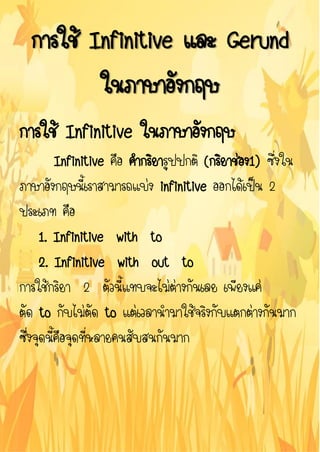


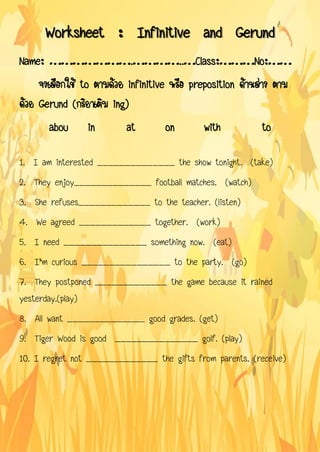
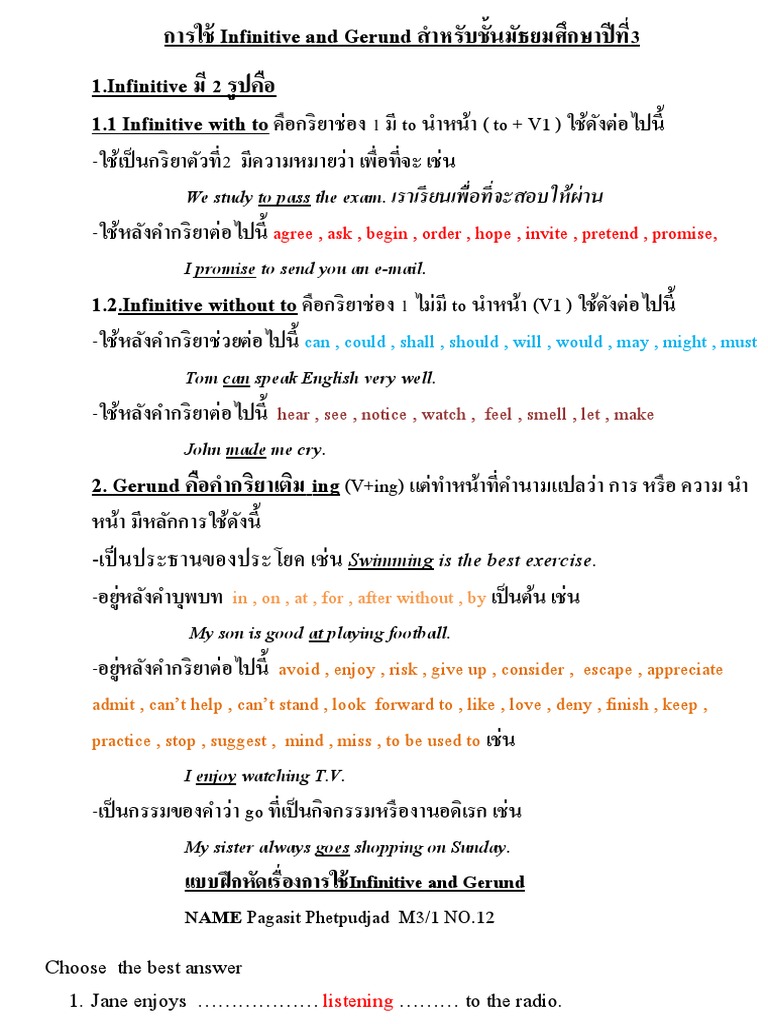


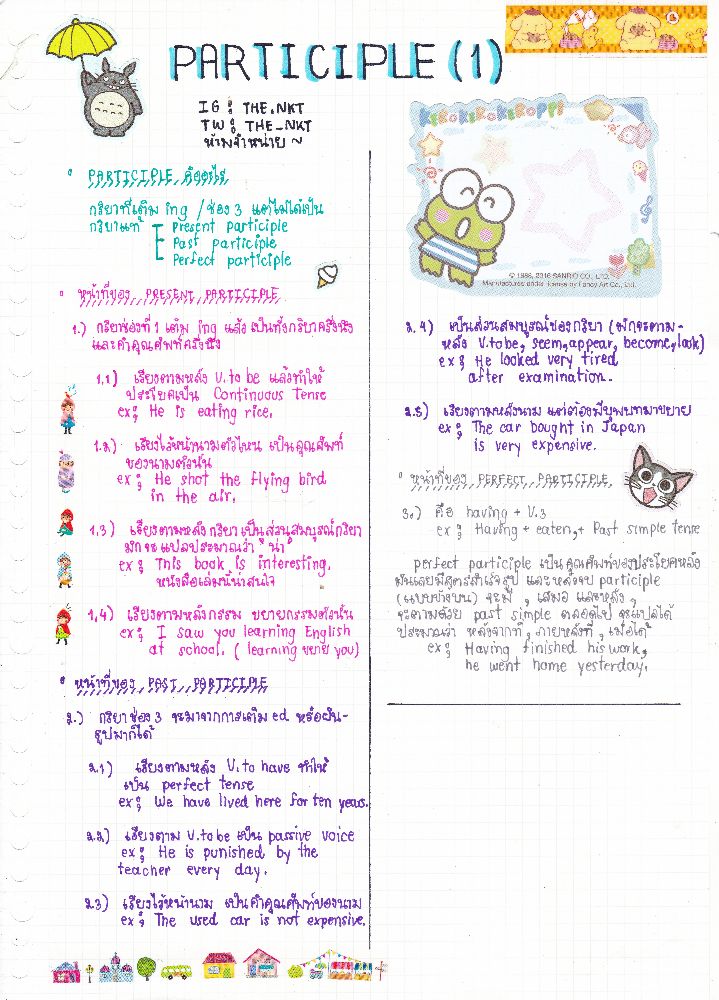




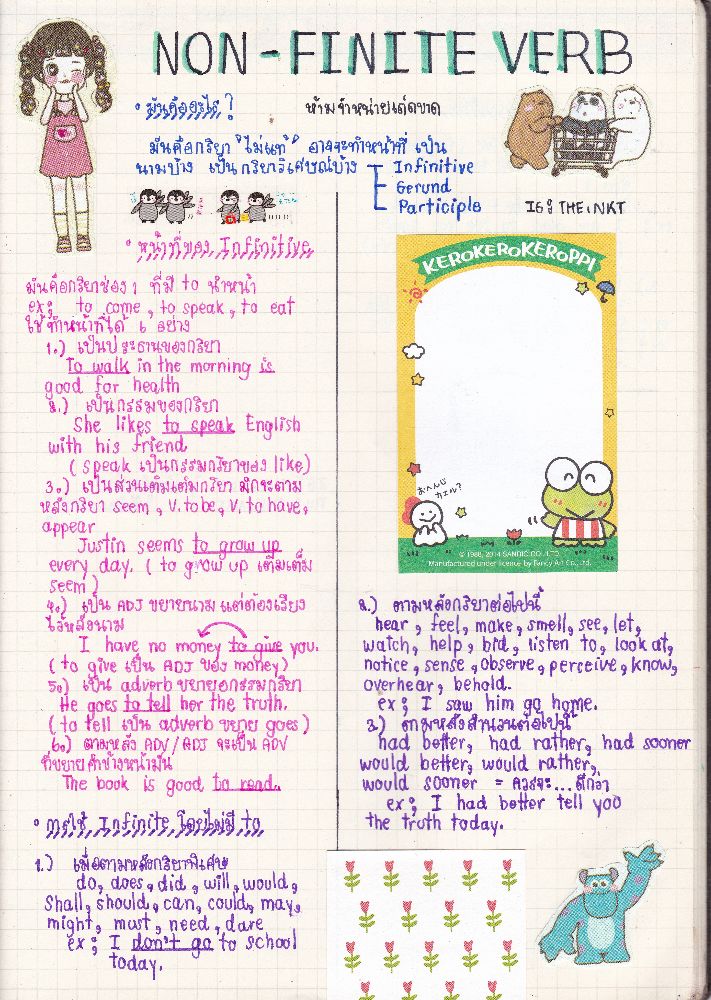


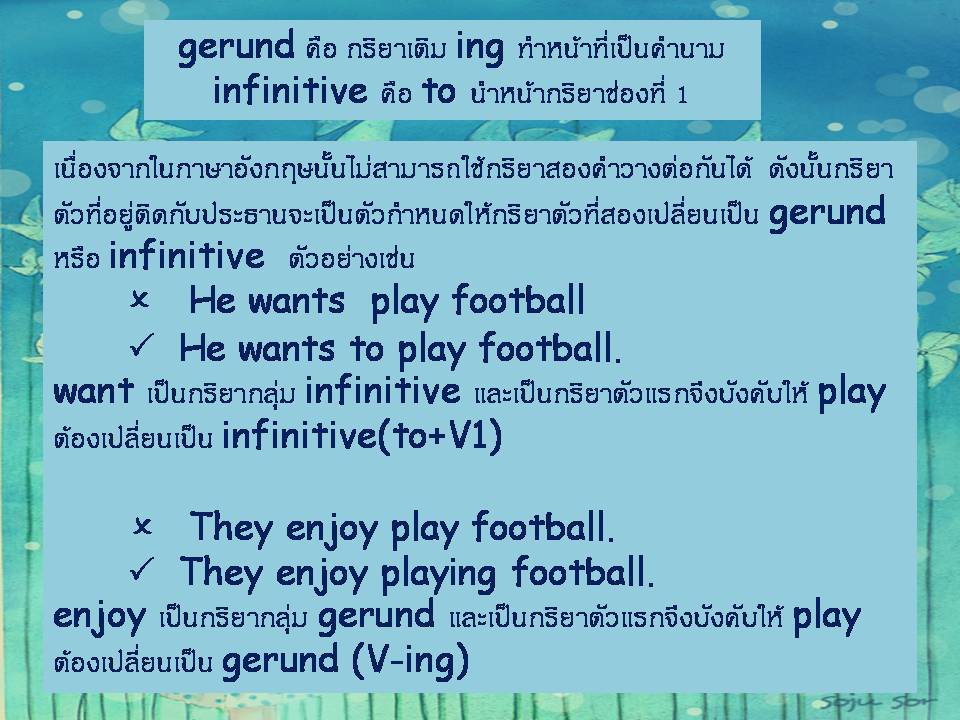

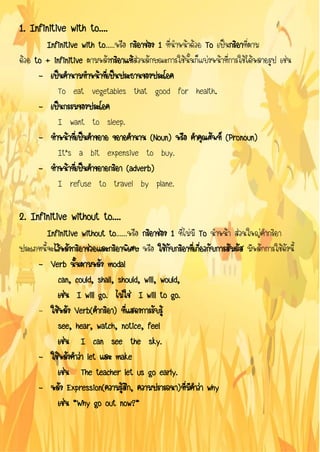



![หลักการใช้ Infinitive ในภาษาอังกฤษ [Infinitives with to] #ติวแกรมมาร์ #ติวTOEIC - YouTube หลักการใช้ Infinitive ในภาษาอังกฤษ [Infinitives With To] #ติวแกรมมาร์ #ติวToeic - Youtube](https://i.ytimg.com/vi/vc_cL5a4zdc/maxresdefault.jpg)









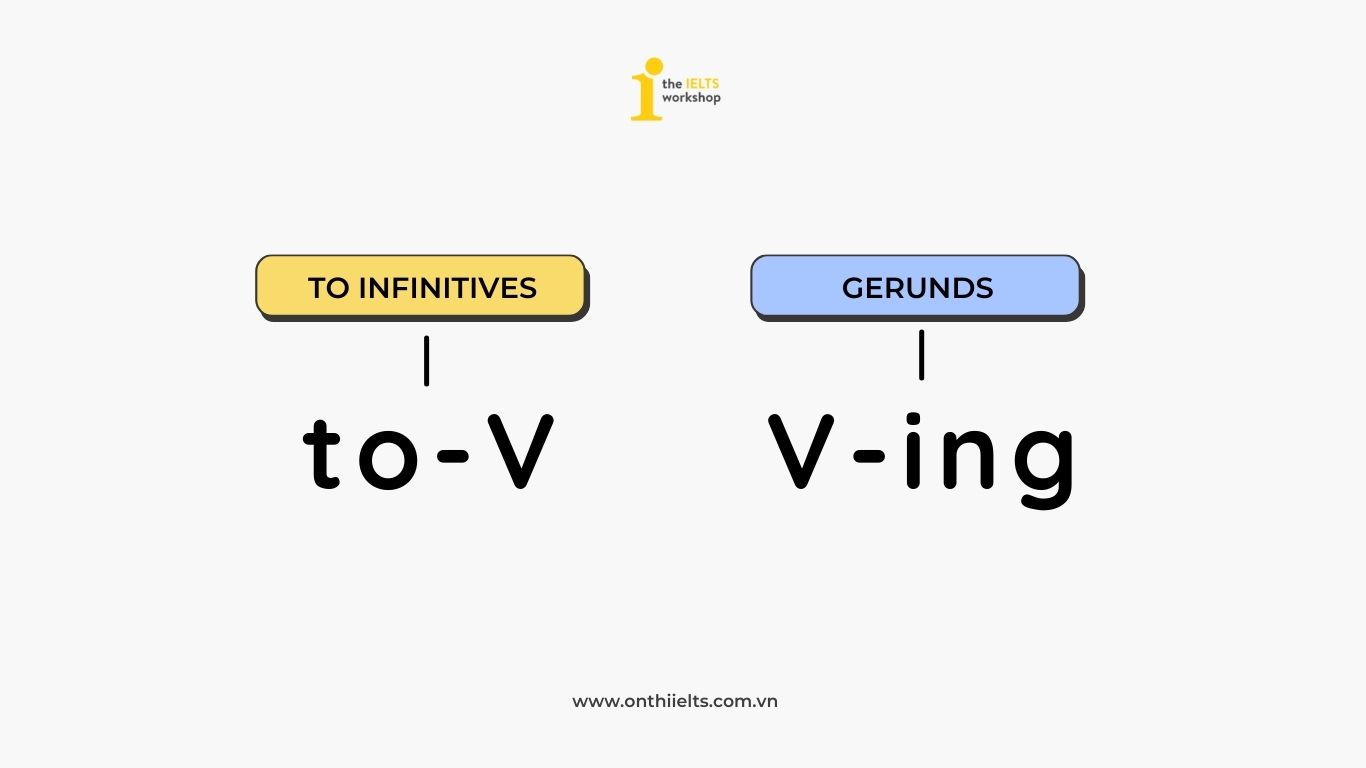

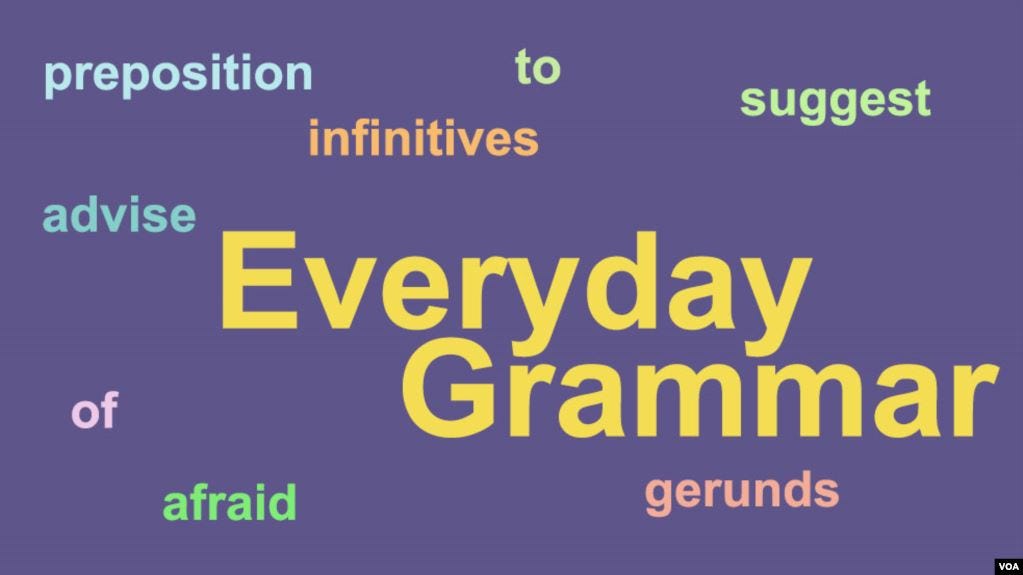
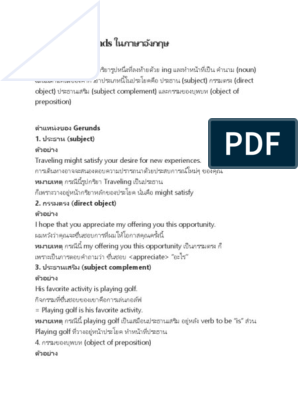

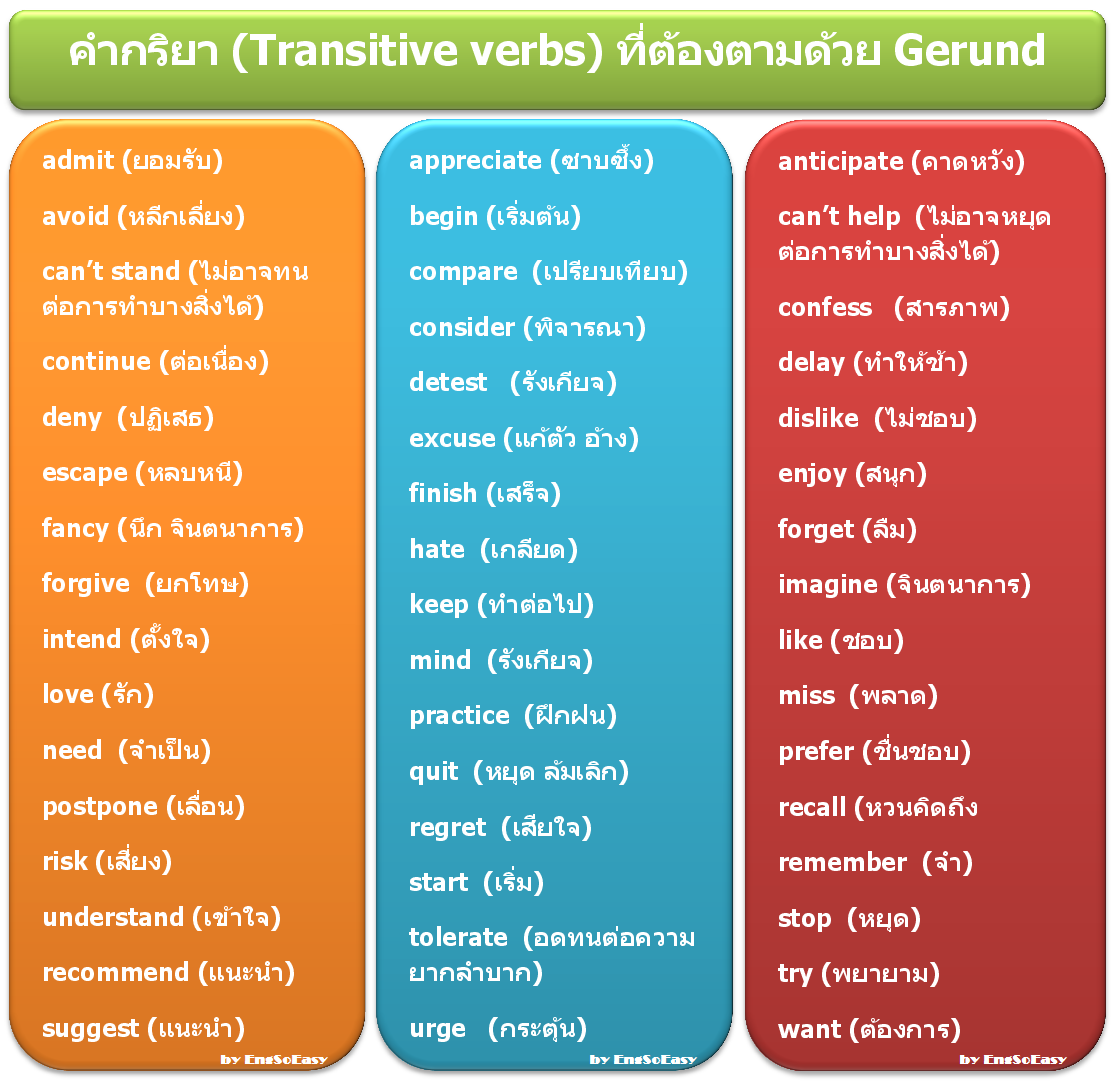
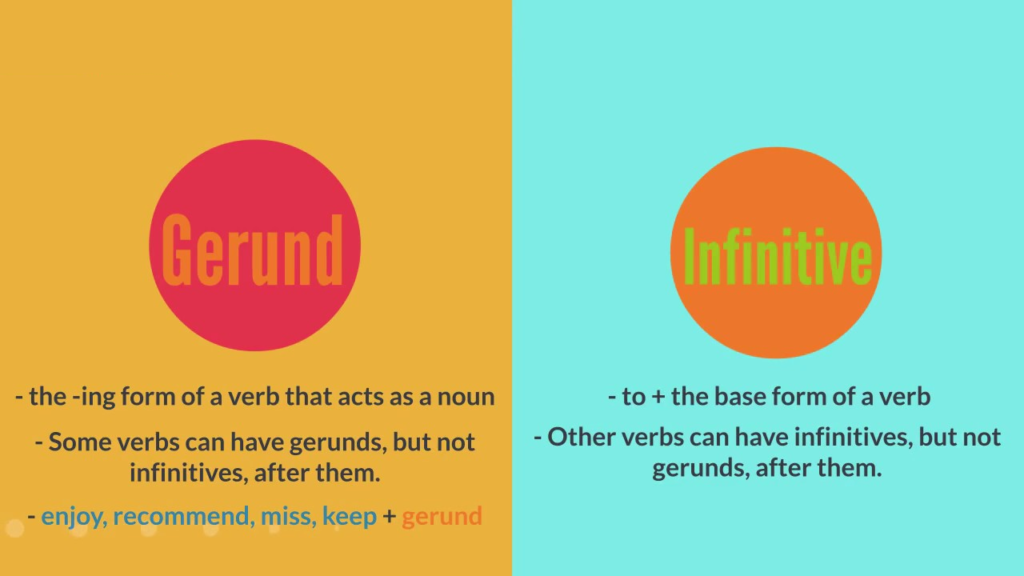
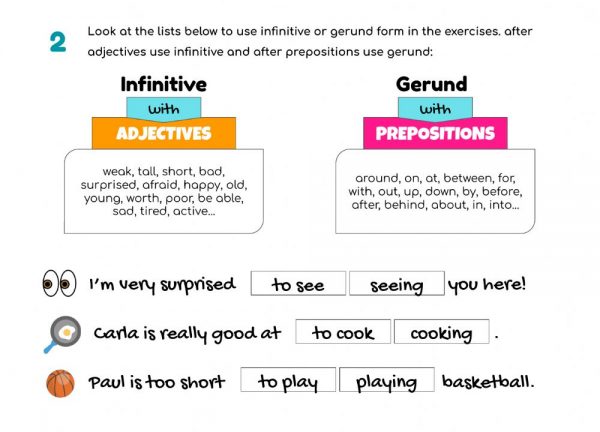


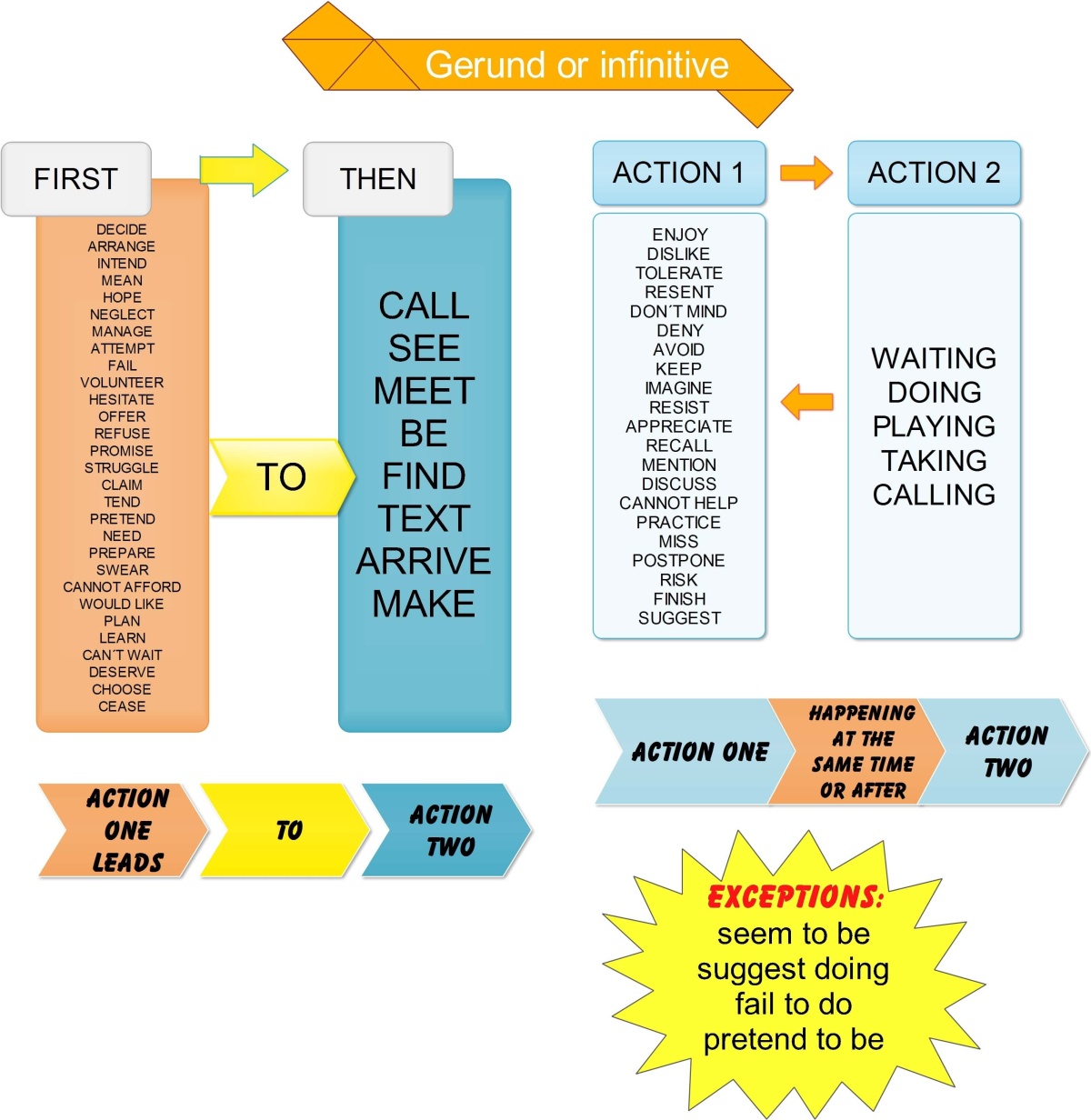


ลิงค์บทความ: การใช้ gerund and infinitive.
ดูข้อมูลเพิ่มเติมเกี่ยวกับโพสต์หัวข้อนี้ การใช้ gerund and infinitive.
- Gerund & Infinitive ฉบับเข้าใจง่าย! แถมศัพท์คำกริยาพบบ่อยที่มักจะ …
- Infinitive กับ Gerund ต่างกันอย่างไร ใช้อย่างไร ใช้กับคำกริยาอะไร
- gerund and infinitive คืออะไร สรุปไวยากรณ์อังกฤษทั้งสองเรื่องสั้นๆ …
- Gerund และ to infinitive แกรมม่าต้องรู้ก่อนสอบ TOEIC
- Gerund และ Infinitive – Google Docs
- การใช้ Gerund | EF | ประเทศไทย – EF Education First
- Infinitive คืออะไร การใช้ Infinitive with to กับ Infinitive without to ต่างกันอย่างไร
- Grammar: Infinitive คืออะไร? หลักการใช้ Infinitive ในภาษาอังกฤษ
- เข้าใจ Gerund หรือ Verb + ing ใน 5 นาที ใช้ยังไง? ต้องตามหลัง …
- การใช้ gerund and infinitive ต่างกันอย่างไร | ภาษาอังกฤษ
ดูเพิ่มเติม: https://phauthuatdoncam.net/tv-shows-a-z blog